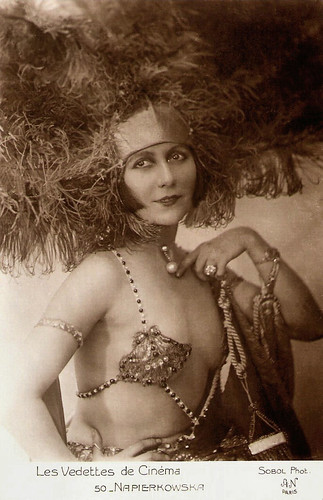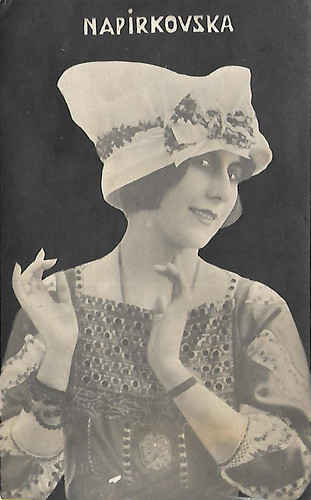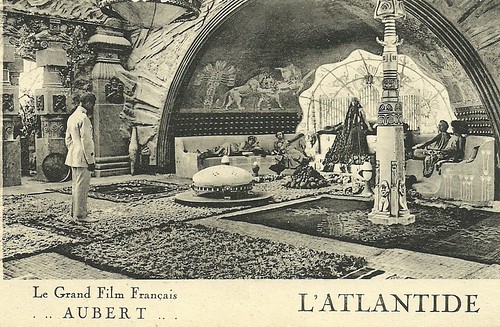This week we follow the 37th edition of Le Giornate del Cinema Muto, the world’s leading international silent-film festival in Pordenone. One of the highlights of the festival is the classic fantasy L’Atlantide/Missing Husbands (1921). The exotic French actress and dancer Stacia Napierkowska (1886-1945) starred as the seductive but cruel Queen Antinéa. Between 1908 and 1926, this fascinating star of the silent cinema appeared in 86 films.
![Stacia Napierkowska]()
French postcard in the series Les Vedettes de Cinéma by A.N., Paris, no. 50. Photo: Sobol.
![Stacia Napierkowska]()
French postcard by MvB, no. 3016. Mailed in 1908.
![Stacia Napierkowska]()
French postcard by Editions Pathé Frères. Photo: A. Bert.
![Stacia Napierkowska]()
French postcard in the series Nos artistes dans leur loge, no. 207. Photo: Comoedia.
Stacia Napierkowska was born Renée Claire Angèle Élisabeth Napierkowski in Paris, France, in 1886 (some sources say 1891; and in the magazine Mon Ciné (no. 17, 1922) she even declared to be born in 1896). Her parents were Polish.
Like Mistinguett, she debuted as a dancer in the revues of the Folies-Bergère. Then she danced in a revival of Lysistrata by Maurice Donnay at the Bouffes-Parisiens. Albert Carré director of the Opéra Comique spotted her and engaged her for the production Fêtes Romaines (Roman Holiday), which he presented at the Théâtre Antique d'Orange. Her performance, but especially her statuesque body and her beauty, triggered an indescribable enthusiasm from thousands of spectators. The public’s fascination for her would endure for twenty years.
In 1908, when she was already a star dancer at the Opéra Comique, Napierkowska made her film debut in L'empreinte ou la main rouge/The mark or The Red Hand (Paul Henri Burguet, 1908) with Max Dearly and Mistinguett. Philippe Pelletier at Ciné Artistes writes that “her perfect physique, her long black hair and dark eyes were quickly put to use to interpret exotic roles for productions of the Société Cinématographique des Auteurs et Gens de Lettres (Film Society of Authors and Men of Letters) directed by Albert Capellani”.
Stacia Napierkowska often inserted dances into her film performances, such as in Dans l'Hellade/In Hellas (Charles Decroix, 1909), Cléopâtre/Cleopatra (Ferdinand Zecca, Henri Andréani, 1910) where she is a messenger who is poisoned and dances a dance of death, and Le pain des petits oiseaux/The Bread of Little Birds (Albert Capellani, 1911), in which she becomes a dance star.
Several Internet sources like Ciné-Artistes state that Stacia performed Queen Semiramis in Le sérail en dix volets/Sémiramis (Camille Morlhon, 1910), but that is incorrect - existing film copies show that the role was played by Yvonne Mirval. Stacia did play a very voluptuous - and again dancing - Esmeralda in an early silent adaptation of Victor Hugo’s Notre-Dame de Paris/The Hunchback of Notre Dame (Albert Capellani, 1911), opposite Henry Krauss as Quasimodo.
![Stacia Napierkowska]()
French postcard, 1904. Mailed in 1908.
![Stacia Napierkowska]()
French postcard by MvB, no. 3016.
![Stacia Napierkowska]()
French postcard by Editions Renaissance, Paris.
![Stacia Napierkowska]()
Russian postcard. Collection: Didier Hanson.
Max Linder, always looking for pretty women, engaged Stacia Napierkowska as his partner in several short comedies like Max lance la mode/Max Sets the Fashion (René Leprince, Max Linder, 1912). In Spain she did a dance tour and appeared in the film Max toréador (Max Linder, 1913).
Stacia Napierkowska then set course to the United States with The Captive. This ballet captured the American public, but not the censors. In 1913, she was arrested during a performance in New York City which was declared indecent. After returning to France, Napierkowska stated in the New York Times (27 April 1913): "Really, I have not brought away a single pleasant memory from the United States" and "What a narrow-minded people they are -- how utterly impervious to any beautiful impression!"
In France her successful film career continued. She appeared as Marfa Koutiloff in the popular serial Les Vampires/The Vampires (Louis Feuillade, 1915) starring the equally exotic Musidora.
Then Napierkowska went immediately to Rome to star in Lo stratagemma di Stasià/Stacia’s Stratagem (Ugo Falena, 1915) and a score of other Italian short films during the early years of World War I. In Rome, she tried to convince her close friend, journalist Germaine Dulac, to start making films. Dulac finally agreed on condition that Stacia would participate in her second film, the adventure Venus Victrix/In the storm of life (Germaine Dulac, 1917).
Stacia Napierkowska also directed a short silent film herself, L'Héritière de la manade/The Heiress of the Manade (Stacia Napierkowska, 1917). Then she took a break from the cinema and ballet to rest.
![Stacia Napierkowska]()
French postcard. Photo Pathé.
![Stacia Napierkowksa]()
French postcard. Photo: X.
![Stacia Napierkowska]()
French postcard by Pathé Frères. Photo: A. Bert.
![Stacia Napierkowska]()
French postcard by Cinémagazine-Edition, Paris, no. 229. Sent by mail in 1928. Photo: Studio G.L. Manuel Frères.
Stacia Napierkowska is probably best known for her role as Antinéa, Queen of Atlantis, in the fantasy film L'Atlantide/Missing Husbands (Jacques Feyder, 1921). The director approached her for this part in 1919.
IMDb cites director Jacques Feyder about this meeting: "Miss Napierkowska was an extraordinary dancer. I had seen her at a dance festival where she, as slim as a flower stalk, had been enthusiastically applauded by a crowd of Parisians admirers. A year later, having to choose actors for L'Atlantide, I proposed her for the leading part of Antinéa and the producer agreed; so, in a cold December afternoon, she was in my office, all wrapped in a fur coat, to sign the contract. I thought I did not remember so a plump face but my doubt vanished in a moment because I was too happy for having her in my film, and she left the office without having put off her coat.
The first costume rehearsal was an ugly surprise for me: during last year she had gained a thirty pounds of weight at least. Of course there was nothing to do but hoping that a hard work and the burning sun of Sahara could get my Antinéa a little less fat. It happened just the opposite: the air of the desert whetted her appetite more and more. The dresser complained for having to enlarge the costumes almost every day. Our headquarters were at Touggourt, in a hotel where the food was simply delicious, and because of it my most important occupations were to take away as much bread as possible from her table and tell her dreadful tales about the terrible effects of cream pastry when eaten under the tropical sun."
Despite an exuberance of boas, ostrich feathers and leopard skins, the filmmaker struggled to hide the overweight of his diva during the shooting in 1920. Finally, she would not dance in the film and merely played the vamp with her eyes. However, L'Atlantide/Atlantis became a great success and turned Stacia Napierkowska into one of the legends of the silent cinema.
Napierkowska made a few more films. Her last screen role was Salomé in Le berceau de dieu/The Cradle of God (Fred LeRoy Granville, 1926) starring Léon Mathot. After that she retired. Philippe Pelletier writes that she “then quickly sank into oblivion.”
Stacia Napierkowska died in 1945 in her hometown Paris. She was 58.
![L'Atlantide]()
French postcard for the Louis Aubert production L'Atlantide (1921) by Jacques Feyder, based on the novel by Pierre Benoit. The card depicts the French captain Morhange (Jean Angelo) received by the mysterious and cruel desert queen Antinéa (Stacia Napierkowska). The sets were by Manuel Orazi.
![Stacia Napierkowska]()
French postcard by Editions Filma in the series Les Vedettes du Cinéma, no. 14. Photo: Films Eclipse.
Scene from Les Vampires/The Vampires (1915). Source: Cid Vale Ferreira (YouTube).
Scene from L'Atlantide/Missing Husbands (1921). Source: astique 333 (YouTube).
Sources: Philippe Pelletier (Ciné Artistes) (French), Mon Ciné (Virtual History), Wikipedia and IMDb.

French postcard in the series Les Vedettes de Cinéma by A.N., Paris, no. 50. Photo: Sobol.

French postcard by MvB, no. 3016. Mailed in 1908.

French postcard by Editions Pathé Frères. Photo: A. Bert.

French postcard in the series Nos artistes dans leur loge, no. 207. Photo: Comoedia.
Indescribable Enthusiasm
Stacia Napierkowska was born Renée Claire Angèle Élisabeth Napierkowski in Paris, France, in 1886 (some sources say 1891; and in the magazine Mon Ciné (no. 17, 1922) she even declared to be born in 1896). Her parents were Polish.
Like Mistinguett, she debuted as a dancer in the revues of the Folies-Bergère. Then she danced in a revival of Lysistrata by Maurice Donnay at the Bouffes-Parisiens. Albert Carré director of the Opéra Comique spotted her and engaged her for the production Fêtes Romaines (Roman Holiday), which he presented at the Théâtre Antique d'Orange. Her performance, but especially her statuesque body and her beauty, triggered an indescribable enthusiasm from thousands of spectators. The public’s fascination for her would endure for twenty years.
In 1908, when she was already a star dancer at the Opéra Comique, Napierkowska made her film debut in L'empreinte ou la main rouge/The mark or The Red Hand (Paul Henri Burguet, 1908) with Max Dearly and Mistinguett. Philippe Pelletier at Ciné Artistes writes that “her perfect physique, her long black hair and dark eyes were quickly put to use to interpret exotic roles for productions of the Société Cinématographique des Auteurs et Gens de Lettres (Film Society of Authors and Men of Letters) directed by Albert Capellani”.
Stacia Napierkowska often inserted dances into her film performances, such as in Dans l'Hellade/In Hellas (Charles Decroix, 1909), Cléopâtre/Cleopatra (Ferdinand Zecca, Henri Andréani, 1910) where she is a messenger who is poisoned and dances a dance of death, and Le pain des petits oiseaux/The Bread of Little Birds (Albert Capellani, 1911), in which she becomes a dance star.
Several Internet sources like Ciné-Artistes state that Stacia performed Queen Semiramis in Le sérail en dix volets/Sémiramis (Camille Morlhon, 1910), but that is incorrect - existing film copies show that the role was played by Yvonne Mirval. Stacia did play a very voluptuous - and again dancing - Esmeralda in an early silent adaptation of Victor Hugo’s Notre-Dame de Paris/The Hunchback of Notre Dame (Albert Capellani, 1911), opposite Henry Krauss as Quasimodo.

French postcard, 1904. Mailed in 1908.

French postcard by MvB, no. 3016.

French postcard by Editions Renaissance, Paris.

Russian postcard. Collection: Didier Hanson.
American Censors
Max Linder, always looking for pretty women, engaged Stacia Napierkowska as his partner in several short comedies like Max lance la mode/Max Sets the Fashion (René Leprince, Max Linder, 1912). In Spain she did a dance tour and appeared in the film Max toréador (Max Linder, 1913).
Stacia Napierkowska then set course to the United States with The Captive. This ballet captured the American public, but not the censors. In 1913, she was arrested during a performance in New York City which was declared indecent. After returning to France, Napierkowska stated in the New York Times (27 April 1913): "Really, I have not brought away a single pleasant memory from the United States" and "What a narrow-minded people they are -- how utterly impervious to any beautiful impression!"
In France her successful film career continued. She appeared as Marfa Koutiloff in the popular serial Les Vampires/The Vampires (Louis Feuillade, 1915) starring the equally exotic Musidora.
Then Napierkowska went immediately to Rome to star in Lo stratagemma di Stasià/Stacia’s Stratagem (Ugo Falena, 1915) and a score of other Italian short films during the early years of World War I. In Rome, she tried to convince her close friend, journalist Germaine Dulac, to start making films. Dulac finally agreed on condition that Stacia would participate in her second film, the adventure Venus Victrix/In the storm of life (Germaine Dulac, 1917).
Stacia Napierkowska also directed a short silent film herself, L'Héritière de la manade/The Heiress of the Manade (Stacia Napierkowska, 1917). Then she took a break from the cinema and ballet to rest.

French postcard. Photo Pathé.

French postcard. Photo: X.

French postcard by Pathé Frères. Photo: A. Bert.

French postcard by Cinémagazine-Edition, Paris, no. 229. Sent by mail in 1928. Photo: Studio G.L. Manuel Frères.
Queen of Atlantis
Stacia Napierkowska is probably best known for her role as Antinéa, Queen of Atlantis, in the fantasy film L'Atlantide/Missing Husbands (Jacques Feyder, 1921). The director approached her for this part in 1919.
IMDb cites director Jacques Feyder about this meeting: "Miss Napierkowska was an extraordinary dancer. I had seen her at a dance festival where she, as slim as a flower stalk, had been enthusiastically applauded by a crowd of Parisians admirers. A year later, having to choose actors for L'Atlantide, I proposed her for the leading part of Antinéa and the producer agreed; so, in a cold December afternoon, she was in my office, all wrapped in a fur coat, to sign the contract. I thought I did not remember so a plump face but my doubt vanished in a moment because I was too happy for having her in my film, and she left the office without having put off her coat.
The first costume rehearsal was an ugly surprise for me: during last year she had gained a thirty pounds of weight at least. Of course there was nothing to do but hoping that a hard work and the burning sun of Sahara could get my Antinéa a little less fat. It happened just the opposite: the air of the desert whetted her appetite more and more. The dresser complained for having to enlarge the costumes almost every day. Our headquarters were at Touggourt, in a hotel where the food was simply delicious, and because of it my most important occupations were to take away as much bread as possible from her table and tell her dreadful tales about the terrible effects of cream pastry when eaten under the tropical sun."
Despite an exuberance of boas, ostrich feathers and leopard skins, the filmmaker struggled to hide the overweight of his diva during the shooting in 1920. Finally, she would not dance in the film and merely played the vamp with her eyes. However, L'Atlantide/Atlantis became a great success and turned Stacia Napierkowska into one of the legends of the silent cinema.
Napierkowska made a few more films. Her last screen role was Salomé in Le berceau de dieu/The Cradle of God (Fred LeRoy Granville, 1926) starring Léon Mathot. After that she retired. Philippe Pelletier writes that she “then quickly sank into oblivion.”
Stacia Napierkowska died in 1945 in her hometown Paris. She was 58.

French postcard for the Louis Aubert production L'Atlantide (1921) by Jacques Feyder, based on the novel by Pierre Benoit. The card depicts the French captain Morhange (Jean Angelo) received by the mysterious and cruel desert queen Antinéa (Stacia Napierkowska). The sets were by Manuel Orazi.

French postcard by Editions Filma in the series Les Vedettes du Cinéma, no. 14. Photo: Films Eclipse.
Scene from Les Vampires/The Vampires (1915). Source: Cid Vale Ferreira (YouTube).
Scene from L'Atlantide/Missing Husbands (1921). Source: astique 333 (YouTube).
Sources: Philippe Pelletier (Ciné Artistes) (French), Mon Ciné (Virtual History), Wikipedia and IMDb.